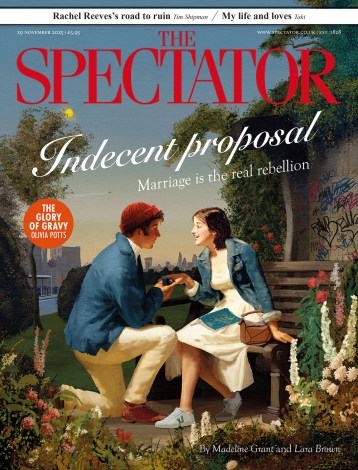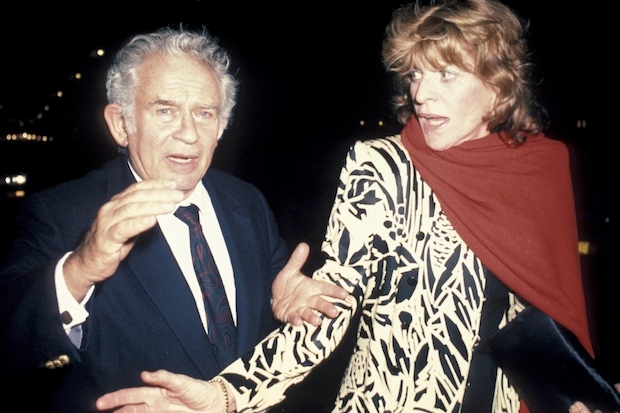Heroically brave and mad, prodigious in his industry and appetites, Norman Mailer was an altogether excessive figure. Since his death in 2007 there have been several biographies, but this is the big one — big enough to accommodate a triple or quadruple life, let alone a double. It is also the official one, written at Mailer’s request by J. Michael Lennon, his friend, collaborator and literary executor, who is respectful and affectionate but not hagiographic.
He calls Mailer a ‘genius’, which in some ways he was, but does not claim that any of his novels were ‘great’, which is just as well. He never glosses over Mailer’s habitually appalling behaviour, and though he has the right he never calls him ‘Norman’. A Double Life is a judicious and comprehensive
portrait of one of the more entertaining monsters of our times.
That title might apply to the lives of any number of writers, but is especially apt of Mailer, whose life positively pullulated with duality. To begin with his parents: a steely and manipulative matriarch, and a shifty gambler and dandy with a dodgy British accent. Mailer grew up in Brooklyn, ‘a tearful, bookish momma’s boy’, given to tantrums and afraid of local Irish gangs. He wrote his first stories aged seven or so, and in 1934, inspired by Edgar Rice Burroughs, a 35,000-word novel about a Martian invasion, which showed, writes Lennon, his ‘bottomless fascination with war, violence and suffering’.
At Harvard in the 1930s undergraduates were classified as ‘white men, gray men and meatballs’, and as a Jew in green and blue striped trousers and a gold jacket Mailer was a meatball. He majored in engineering, but his interests remained literary, and in later life he nurtured a ‘suspicion of all things mechanical and electronic’. He adopted Hemingway as his guide to violence, and D.H. Lawrence to sex, which may explain his enthusiasm for buggery.
In life, art and politics, sex and violence became his vocations and his gods. The greatest number of entries in Lennon’s index occurs under ‘Mailer, Norman: infidelities of’, covering the ins and outs of his six marriages. ‘Smitten by Norris,’ runs a typical summary of his amatory situation, ‘he felt a deep attachment to Carol, but was not quite ready to break off with Suzanne. There were other women as well.’ In the 1960s he was a star of the permissive society, and in the 1970s, thanks to the misogynistic fantasies enacted in his novels, and to such opinions as ‘a little bit of rape is good for a man’s soul’, he became what Lennon calls ‘the piñata’ of women’s lib.
Violence was the making of him — he underwent his war service in the Philippines determined to write the great second world war novel. He later wrote brilliantly about boxing, and not only the fights but the milieu, as in his description of gangsters at a Sonny Liston fight — ‘hawks and falcons and crows, Italian dons looking like little old shrunken eagles, gulls, pelicans, condors’.
In the 700 or so interviews Mailer gave he liked to weave and throw shadow punches, and he saw himself, he wrote in Advertisements for Myself (1959), as ‘a slightly punch-drunk and ugly club fighter, who can fight clean and fight dirty, but likes to fight’. He twice head-butted Gore Vidal, and at a party in 1960 — ‘drunk’, as he recalled, ‘and probably on pot’ — he stabbed and nearly killed his second wife. As he had recently observed of William Burroughs (who did manage to kill his wife), ‘He writes sentences that stab people and you never forget the man who stabs you.’
In The White Negro (1957), his paean to the hipster, Mailer considered the hypothetical case of two 18-year-old hoodlums who kill a candy-store keeper — ‘and no matter how brutal the act, it is not altogether cowardly’. He found Charles Manson not wholly unadmirable, and while researching The Executioner’s Song (1979), his ‘true life novel’ about the murderer Gary Gilmore, he befriended Jack Abbott, another murderer, helped secure his release from prison and arranged the publication of his book, In the Belly of the Beast (1981). A month after his release, Abbott murdered a young Cuban waiter in Greenwich Village. Mailer said he felt ‘very responsible’, but that culture was a risky business. Asked to specify the risk — ‘Cubans? Waiters? What?’ — he repeated, ‘Society has got to take certain risks.’
In May 1948, at the age of 25, he became rich and famous when The Naked and the Dead hit the New York Times bestseller list, where it remained for 62 weeks. He recalled it as ‘a great shock’, and felt that his public persona alienated him from his true self. After a few years, though, he acquired a taste for fame, and it became an addiction. He began to refer to himself in the third person, and kept it up for several books. In The Armies of the Night (1968), for instance, he wrote that, apart from his hero JFK, ‘there had not been a president of the United States nor even a candidate since the second world war, whom Mailer secretly considered more suitable than himself’. He later considered running against Bill Clinton in the Democratic
primaries.
Mailer would seem, then, to have been a stranger to modesty. When he turned his dire Hollywood novel The Deer Park (1955) into an even direr play he declared it ‘better than Death of a Salesman and Streetcar Named Desire put together’. And though ‘a stranger to Christianity’, he felt qualified to write The Gospel According to the Son (1997), because Jesus Christ was a fellow Jewish celebrity.
He most urgently wanted to be great, and liked to shout that he was and, trapped in ‘the bowels of cash flow’, he fought hard to be so. Sometimes he nearly was, but at others he whispered to himself that he might not be. In one of some 45,000 letters, he wrote:
My idea how to live is to feel in one hour that one is the best damned zapped fucker in the US and then spend the next day mourning the tragic depths of one’s profound incompetence.
This is the duality that makes him attractive and interesting.
Lennon omits my favourite Mailer anecdote, perhaps because it is apocryphal. The Naked and the Dead is full of ‘fugs’, and when Mailer was introduced to a young woman at a party she said, ‘Oh you’re the man who can’t spell fuck.’ Occasionally he is too trusting of his subject’s anecdotes, as when, on his way home by train after the war, Mailer gave away all his medals (he only had one). And he too refers to himself in the third person (‘J. Michael Lennon, a young professor’ etc), though doubtless out of scholarly decorum. Quibbles aside, though, A Double Life is a monumental and definitive achievement.






Comments